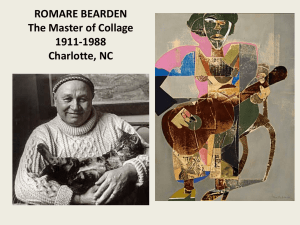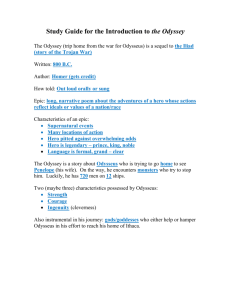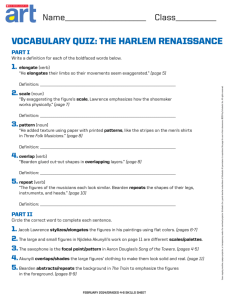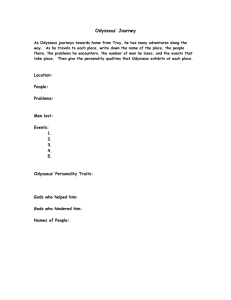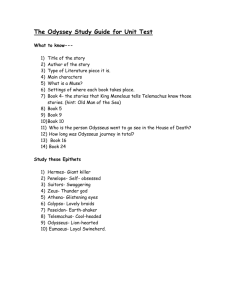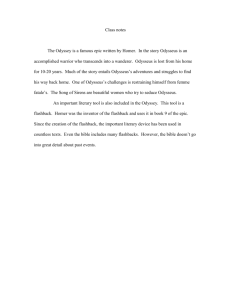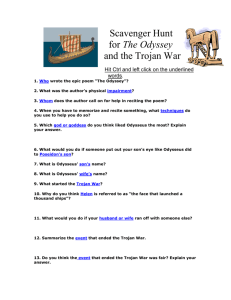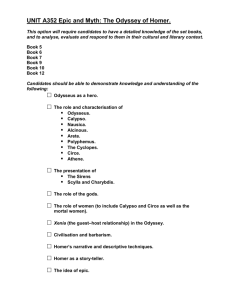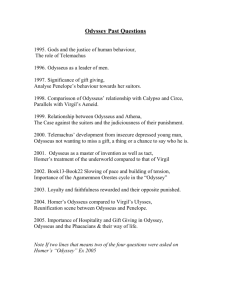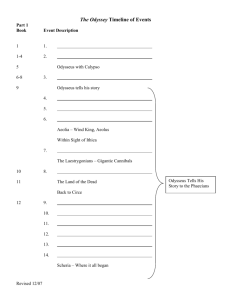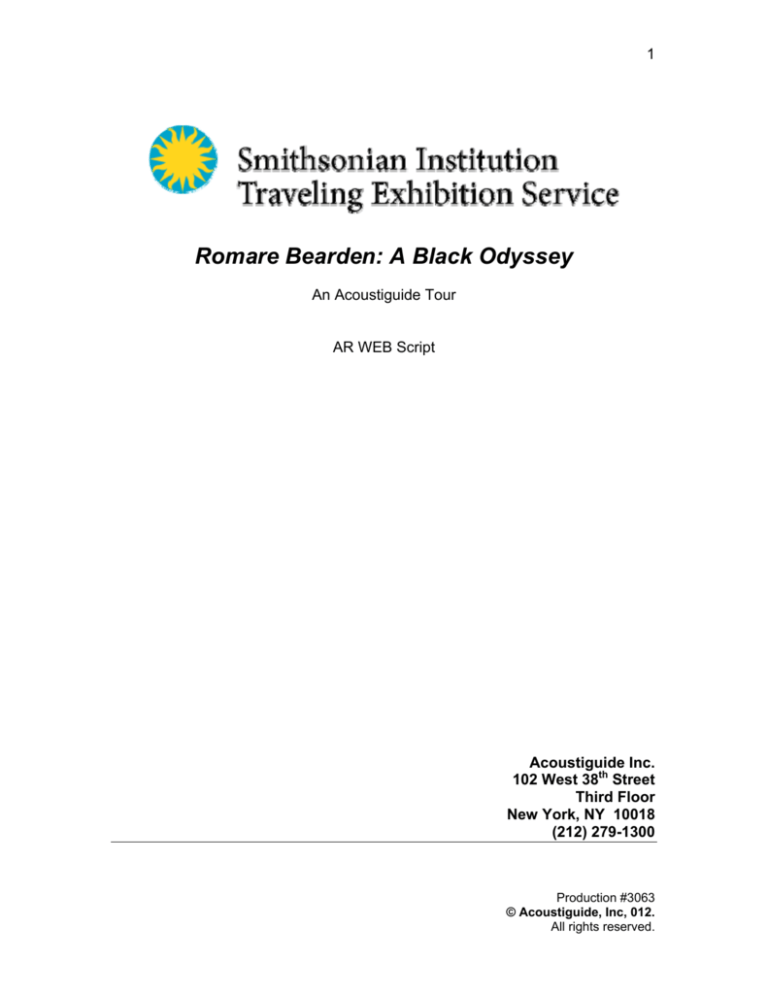
1
Romare Bearden: A Black Odyssey
An Acoustiguide Tour
AR WEB Script
Acoustiguide Inc.
102 West 38th Street
Third Floor
New York, NY 10018
(212) 279-1300
Production #3063
© Acoustiguide, Inc, 012.
All rights reserved.
2
STOP LIST
1: Overview
2: Home to Ithaca
3: Iliad drawing, Untitled, Men with Shields, 194; Iliad drawing, Untitled,
Men with Daggers, 1946; Iliad drawing, Untitled, Color Iliad, 1946
4: The Fall of Troy
5: Battle with Cicones
6: Realm of Shades
7: Poseidon, The Sea God—Enemy of Odysseus
8: Circe
9: Odysseus Leaves Nausicaa
10: The Land of the Lotus Eaters
11: The Sirens’ Song
12: Cattle of the Sun God
13: The Sea Nymph
14: Baptism
15: Image of Bearden at Work
16: Odysseus Meets His Father
17: The Bow of Odysseus
18: Odysseus and Penelope Reunited
19: The Return of Ulysses
20: House in Cotton Field
Production #3063
© Acoustiguide, Inc, 012.
All rights reserved.
3
1. INTRODUCTION
NARRATOR:
SFX: SLOW, SEXY BLUES MUSIC
American Modernist artist Romare Bearden was born in 1911, in North Carolina,
a land of plantations and preachers, but grew up in Harlem, in New York City,
amidst the Harlem Renaissance, a creatively explosive time that saw the
flourishing of black artists, musicians, and writers. The African American
experience of country and city, of home, of myth and memory, of jazz and the
blues, would inspire the colorful, energetic collages that made Bearden famous,
including the series of works you’re about to see: the Black Odyssey.
Based on the ancient story by Homer, “The Odyssey” begins at the end of the
great Trojan War, a ten-year bloody battle that pit two tribes against each other.
It follows Greek war hero Odysseus on his epic journey back home to his son
and wife.
Bearden has said that ‘all of us, from the time we begin to think, are on an
odyssey.’
In ancient Greek, the name Odysseus means trouble, and he gets into a lot of it.
Robert O’Meally, Zora Neale Hurston Professor of English and Comparative
Literature at Columbia University and curator of this exhibition, explains why
this part of the story might have engaged Bearden as an artist.
ROBERT O’MEALLY :
The fact that trouble is the theme, of this book, at the same time that it's triumph,
must have really excited Bearden. I think that for Bearden, who came of age at a
time when jazz was America’s popular music, and when the blues were running
all through everything the idea that you live with trouble is the theme of the blues.
NARRATOR:
And as you’ll see, Bearden makes the Odyssey his own. Throughout this tour,
you’ll be hearing more from Robert O’Meally, as well as from Diedra HarrisKelley, Bearden’s niece and co-director of the Romare Bearden Foundation,
and from archival interviews with Bearden himself. Artist, writer and
musician, Paul Miller, aka DJ Spooky, will contribute his own thoughts
about Bearden’s genius. You’ll also hear quotes from Homer’s tales, and jazz,
blues, and even hip-hop music that mirror Bearden’s improvisational approach to
making art.
Romare Bearden: A Black Odyssey,” is organized by the Smithsonian Institution
Traveling Exhibition Service in cooperation with the Romare Bearden Foundation
and Estate and DC Moore Gallery.
Production #3063
© Acoustiguide, Inc, 012.
All rights reserved.
4
The exhibition and its related educational resources are supported by a grant
from the Stavros Niarchos Foundation.
[word count 394] 2. HOME TO ITHACA
NARRATOR:
The man standing at the bow of the ship is Odysseus, and this is his
homecoming, 20 long years in the making.
Like the best jazz and hip-hop musicians who take existing melodies, beats and
rhythms to create something entirely new, here Bearden is riffing on Homer’s
Odyssey and making it his own. For starters, in the original story, when
Odysseus’ ship reaches shore, he’s asleep on the deck... a surprisingly unheroic
re-entry. To Bearden, it’s a moment of triumph, the hero coming home. Bearden
also makes all the characters in his story black.
He believed the Odyssey echoed the African American experience. Professor
Robert O’Meally.
ROBERT O’MEALLY:
For him, part of the tension was hey, how fascinating it is as a black painter to
say, this story belongs to us, as to everyone else. Part of the reason he chose
“The Odyssey” is that the epic story of the African-American’s journey from Africa
through slavery, toward freedom, is as great an epic story as there is. At the
same time that we look at the story of black Americans tryin' to find their way
home.
NARRATOR:
Here’s Bearden:
ROMARE BEARDEN ARCHIVAL AUDIO:
And this is what I’ve tried to do in my collages . . . to bring the Afro-American
experience into art and give it a universal dimension.”
NARRATOR:
DJ Spooky.
DJ SPOOKY:
In the black odyssey he’s drawing a connection to the Greeks, the root of
western civilization. So he’s looking at the roots of the west and the roots of
himself and that’s a mashup. He’s mashing up two records, he’s putting the
rolling stones with Wu Tang Clan.
Production #3063
© Acoustiguide, Inc, 012.
All rights reserved.
5
[word count 290] 3. ILIAD DRAWINGS, Untitled, Men with Shields, 194; Iliad drawing,
Untitled, Men with Daggers, 1946; Iliad drawing, Untitled, Color Iliad, 1946
NARRATOR:
The Odyssey wasn’t the first time Bearden drew inspiration from Homer. In the
late 1940s, Bearden was working primarily in pen-and-ink and made a series of
drawings based on The Iliad, Homer’s story about the Trojan War. It’s the battle
that leads up to the events in The Odyssey.
ROBERT O’MEALLY:
It’s a story that tears you apart, because you're rooting for the heroes and then
you realize that the heroes are bloodthirsty and they're killing the people and
destroying the ones that we also love. It's a great tragic epic.
NARRATOR:
Revenge and personal honor drive the warriors to commit deplorable acts. Just
listen to what one warrior says to another after ramming him with a blade:
ACTOR: MALE VOICE:
You dog! I wish my stomach would let me Cut off your flesh in strips and eat it
raw for what you’ve done to me. (Iliad Book 22, line 384)
NARRATOR:
Having served on the home front during World War II, Bearden understood the
inhumanity of war all too well. With a few quick, slashing lines Bearden
masterfully captured the energy and brutality of war. Where does one warrior
begin and another one end?
ROBERT O’MEALLY:
In these drawings, he’s reminding us that one figure attacking another can be
almost like the figure attacking itself. The terrible doubt that it's nothing but
suicide on some other level, is always there.
[word count: 242]
4. THE FALL OF TROY
NARRATOR:
War is hell. Homer knew it. So did Bearden. This is his interpretation of the Fall of
Troy—the decisive moment of the Trojan War. On the right, that’s the Trojan
horse, perhaps the most brilliant fake-out in the history of warfare. It’s our hero
Production #3063
© Acoustiguide, Inc, 012.
All rights reserved.
6
Odysseus who comes up with the plan to build a huge, hollow wooden horse to
offer as a ‘gift’ to the enemy, the Trojans. What the Trojans don’t know is that it’s
filled with soldiers, who, at nightfall, creep out of the horse and pillage and burn
their city.
Here Bearden creates his own distinct vision, perhaps conjuring both the horrors
of World War II and the bloody legacy of the American Civil War.
ROBERT O’MEALLY:
This is a world in trouble, a world on fire, a world cut in half. There's a
suggestion everywhere of humanity turned against it, the city turned against
itself.
What he adds to it are flames that we don’t see in the poem by Homer. He
floods the scene with water, as if to remind us that there's some continuity
beyond the burning city. That everything may be lost and yet there are these
waters. And for Bearden, water, again and again, has to do with cleansing and
renewal and baptism.
NARRATOR:
And those waters will carry Odysseus along in his journey.
[word count: 227]
5: BATTLE WITH CICONES
NARRATOR:
After the Fall of Troy, Odysseus and his men begin their journey home. But we
know Odysseus literally means trouble, and trouble is what they get when they
decide to stop off and attack the capital city of the tribe the Cicones.
ACTOR MALE VOICE: FROM THE ODYSSEY
“We took their wives and also much booty, which we divided equitably amongst
us, so that none might have reason to complain. I then said that we had better
make off at once, but my men very foolishly would not obey me, so they stayed
there drinking much wine and killing great numbers of sheep and oxen on the
sea shore.“
NARRATOR:
And that’s when the Ciconian reinforcements arrive and drive Odysseus and his
men back to their ships.
Here Bearden depicts a scene of beauty and chaos...it’s hard to tell exactly what
is happening.
ROBERT O’MEALLY:
Production #3063
© Acoustiguide, Inc, 012.
All rights reserved.
7
One of them seems to be in a Native American headdress, and what does that
mean? Bearden is making us wonder about ’’ the question of race and of nation,
of colonial exploitation; of leadership and the need to be alert and not sleepy and
self-indulgent and silly in the way that Odysseus often could be.
NARRATOR:
Here Homer let us know that Odysseus is flawed, just like the rest of us.
ROBERT O’MEALLY:
He’s heroic in so many ways. He’s a terrific athlete, he’s a wonderful storyteller,
He’s a military strategist. He’s the fanciful lover with goddesses fighting over
him. .And yet, he’s impulsive, he’s foolish.
[word count: 258]
6: REALM OF SHADES
ACTOR: FEMALE VOICE FROM THE Odyssey
At dawn the next day, Odysseus roused his men and told them that the time had
come for them to sail once more, and great indeed was their joy when they heard
his words. But their rejoicing was turned to grief when they learnt it was not to
Ithaca but to the land of the dead that they were to voyage first.
NARRATOR:
Odysseus is told he must go there to learn his future. What he visited was not
‘fire and brimstone’ hell as we know it, but the realm of the dead. And there he
meets the ghosts of his past, including his dead mother and his fallen comrades
from the Trojan War.
Bearden creates a ghoulish scene, indeed. Skeletal figures crowd the building on
the right, perch expectantly, litter the foreground. The bright, claw-like flames are
Bearden’s flourish, invoking perhaps the Christian imagery of hell. At center may
be the blind oracle Tiresias, who prophesizes that Odysseus still has a long
journey ahead. And is that Odysseus on the left, in an African mask, with spear
and shield in hand?
With his powerful, evocative imagery, Bearden creates a scene of misery, a
reminder that life after death is an uncertain thing and could be disastrous. It’s
something Odysseus will remember when, a little farther along into his journey,
he is promised immortality but chooses a mortal’s life instead.
[word count: 233]
7: POSEIDON, THE SEA GOD—ENEMY OF ODYSSEUS
Production #3063
© Acoustiguide, Inc, 012.
All rights reserved.
8
NARRATOR:
Meet Poseidon, King of the Sea, and Odysseus’s great foe. According to Homer,
Poseidon had African lineage.
ROBERT O’MEALLY:
Bearden is fascinated by the African-ness of Poseidon as created by Homer.
Buthe’s not gonna leave out the red-hot fury that is part of the story, too.
NARRATOR:
An angry Poseidon is not to be trifled with, and Odysseus has made him very
mad. As the story goes, early in his journey, Odysseus encountered the oneeyed giant, the Cyclops, who threatened to gobble him up.: Click on the
thumbnail to see how Bearden portrayed him. He escaped by stabbing a spear
into the monster’s single eye. Turns out Cyclops is Poseidon’s son.
ROBERT O’MEALLY:
This man is enraged that his child has been brutalized by Odysseus. And if we
think of the African in the Americas, enraged because of the way his family has
been treated historically by the larger culture, I think that's what gives part of the
force and the fierceness to this particular image.
ACTOR MALE VOICE: From the Odyssey
Poseidon spoke, and pulled the clouds together, in both hands gripping the
trident, and let loose all the terrible stormblasts of all the winds together . . . The
knees of Odysseus gave way for fear, and the heart inside him.
NARRATOR:
Poseidon vows to keep Odysseus away from home for ten years, by stirring up
the seas and sending Odysseus further off course. And yet, Poseidon is just what
our hero Odysseus needs: an unrelenting antagonist.
ROBERT O’MEALLY:
Part of Poseidon’s role is to chase Odysseus so hard that his heroic parts come
into view. And so he’s absolutely indispensable to the tale.
[word count: 276]
8: CIRCE
NARRATOR:
Behold Circe, the bewitching temptress with magical powers. When Odysseus
lands on her island, she transforms his men into swine. This is how Bearden
portrayed that moment.
Production #3063
© Acoustiguide, Inc, 012.
All rights reserved.
9
ROBERT O’MEALLY:
There are more images of Circe than of any other figure from this epic, including
Odysseus. I think Bearden loves her for her special allure and also because
she’s so unpredictable in her powers.
NARRATOR:
For Bearden, Circe hearkens back to the women of his past, specifically the
‘conjur woman,’ who was an important part of black communities in the
Americas. Many were trained priestesses, skilled in a system of spiritual
practices adapted from West Africa and often intermixed with Christian elements.
In this image, Circe’s decked out like an African queen; on the bottom left, the
skull may be a reminder of her deadly powers. And on the right, a snake is coiled
around her arm. Here’s Diedra Harris-Kelley, Bearden’s niece and co-director of
the Romare Bearden Foundation:
DIEDRA HARRIS-KELLEY:
Many people think the snake means evil. Here it is a beautiful piece of jewelry
wrapped around her arm. She’s fearful, but then you cannot help being attracted
to her. You want to know her magic.
NARRATOR:
Perhaps part of Bearden’s fascination with Circe lies with her strength. Bearden
had many female role models throughout his life, most importantly his mother,
who was a well-connected power broker and politician in Harlem.
DIEDRE HARRIS-KELLEY:
He learned a lot from his mother. And so when he comes to depicting his life and
African-American history you see beautiful women, and how they captivate men,
but yet lead families and do all of these other things, I think he puts that into this.
NARRATOR:
So how does Odysseus escape Circe’s clutches?
Ever the clever strategist, Odysseus makes a deal with Circe: turn his men back
into…men after they’d been transformed into pigs, and he will stay with her for a
year as her lover. She agrees.
After a year of feasting, Odysseus and his crew leave Circe. In Homer’s story,
Circe bids them farewell and advises them on the next part of their journey. He
doesn’t describe Circe’s emotional state. But Bearden does. You can click on the
thumbnail below to see how interpreted that moment– a bed-ridden Circe,
heartbroken, attended to by a maidservant. It’s a familiar composition in
Bearden’s oeuvre. You can click on the thumbnail below to compare it to a work
from seven years earlier, “The Two Moons of Luvernia.’
[word count 117]
Production #3063
© Acoustiguide, Inc, 012.
All rights reserved.
10
9: ODYSSEUS LEAVES NAUSICAA
NARRATOR:
Odysseus is almost home when he meets Nausicaa, yet another beautiful
woman. Bearden rendered this scene not just in collage, but also in watercolor.
ROBERT O’MEALLY:
I think now that he’s not painting with scissors, but with a brush, there's a softer
invitation that the works present.
NARRATOR:
That’s Odysseus, on the far left, with spear in hand, and Nausicaa next to him,
leaning in; poor thing, she’s already smitten with our hero. But as in a classic
blues song, he’s going to leave her anyway.
ROBERT O’MEALLY:
I think that African-American music, particularly the blues, is all about encounters
with enigmatic men and women and circumstances where I love you, but you
don’t love me. I love you, but you left me. And in that sense, Bearden’s
Odysseus series is a blues song or a series of blues-based melodies.
NARRATOR:
Odysseus has crossed paths with so many alluring Goddesses. And yet, he
leaves them all singing the blues.
ROBERT O’MEALLY:
In the largest arc of all, he keeps on going home.
NARRATOR:
So who is this woman he is so eager to return to?
ROBERT O’MEALLY:
Penelope, is a very modern woman in the sense that she wants everything. She
wants to have a home, she wants to have a mate that she can rely on, to return
when he says he will. She wants to have a household that’s hers and that she
runs. But she also is a truly brilliant trickster in her own right. A thinker, a
decision-maker.
NARRATOR:
With Odysseus gone—and presumed dead-- swarms of suitors vie for
Penelope’s attention. She’s not interested. To keep them at bay, Penelope tells
them she is weaving a burial shroud for her father-in-law, and when she’s
finished, she’ll pick one of them to marry. But every night, she unravels the
weaving...so she’s never done. Penelope is a kindred spirit to her husband, with
ruses of her own.
Production #3063
© Acoustiguide, Inc, 012.
All rights reserved.
11
ROBERT O’MEALLY :
And I think it's that power as an independent, mature, somewhat impatient
woman that Bearden was fascinated by.
[word count: 159]
10: THE LAND OF THE LOTUS EATERS
MALE VOICE From the Odyssey:
On the tenth day we reached the land of the Lotus-eater, who live on a food that
comes from a kind of flower. I sent two of my company to see what manner of
men the people of the place might be…They started at once, and went about
among the Lotus-eaters who did them no hurt, but gave them to eat of the lotus,
which was so delicious that those who ate of it left off caring about home, and did
not even want to go back and say what had happened to them.
NARRATOR:
A taste of the lotus makes a man lazy. Makes him forget what home is.
ROBERT O’MEALLY:
Here in this scene, you see the people kind 'a lazily swimming in the water, and
chatting with one another. It's as if for a moment ... the ... warriors say, hey you
know what? Let’s not go home.
NARRATOR:
And when Odysseus saw this was happening to his men, he wasn’t the least bit
tempted to join in. Forgetting what home is may be the worst thing that could
happen to a man. Bearden saw it that way, too.
ROBERT O’MEALLY:
For Bearden, whose work is about memory at every single turn, the idea that
they're gonna forget everything is a tremendous horror.
NARRATOR:
Odysseus drags his men back to the boat and they continue on their journey.
What memories of his own does Bearden bring into this collage?
Beginning in 1973, Bearden and his wife, Nanette, spent several months each
year in Nanette’s ancestral home of St. Martin, a Caribbean island.
Diedra Harris-Kelley, Bearden’s niece and co-director of the Romare Bearden
Foundation:
Production #3063
© Acoustiguide, Inc, 012.
All rights reserved.
12
DIEDRA HARRIS-KELLEY:
This was a place of rejuvenation. He talks about the water, he talks about the
color, the blue of the sky and the blue of the water. And how that gets into his
painting.
NARRATOR:
The landscape in this collage looks arguably more like the Caribbean than
ancient Greece. While on St. Martin, Bearden preferred to work in water colors,
even creating a version of this scene and others from this series in this fluid
medium.
[word count: 111]
11. THE SIRENS’ SONG
NARRATOR:
Imagine you’ve recently been released from the clutches of Circe the
Sorceress…unlike some members of your crew, you’ve avoided being turned into
a pig. You are desperate to get home. But remember, this is Odysseus we’re
talking about--flawed and impulsive. Circe tells him to sail straight past the
beautiful yet deadly Sirens, because…
ACTOR (FEMALE): ODYSSEY
If anyone unwarily draws in too close and hears the singing of the Sirens, his wife
and children will never welcome him home again, for they sit in a green field and
warble him to death with the sweetness of their song. There is a great heap of
dead men's bones lying all around, with the flesh still rotting off them.
ROBERT O’MEALLY:
But Odysseus is so curious, and so much in love with the world as we have it,
good and the bad, and the enticing and the forbidding, that he wants to hear that
song. (Laughs) And so he has his men tie him to the mast of the ship, he makes
them put corks in their own ears so they will not hear the song and be killed by it.
NARRATOR:
Bearden’s landscape evokes an island idyll, and the sirens are depicted as
silhouetted beauties, seducing the sailors from the shore. Odysseus survives the
Sirens’ songs, but having given into temptation, he’s reminded us he’s all-toohuman.
ROBERT O’MEALLY:
Our love for him is increased because he is so human, after all. He’s not so big
and magnificent that we can't stand him because we know he’s not like us. He is
like us.
[word count 275]
Production #3063
© Acoustiguide, Inc, 012.
All rights reserved.
13
12: CATTLE OF THE SUN GOD
NARRATOR:
These are the prized sheep and cattle of the Sun God Helios. Odysseus has
been warned by the oracle against even thinking about going near them.
But Odysseus does. He and his men land on their island. When he leaves the
men alone, they attack and feast on the cattle. An infuriated Helios asks the gods
to punish them. What happens next is something out of a horror film:
ACTOR MALE VOICE: From the Odyssey
The gods began at once to show signs and wonders among us, for the hides of
the cattle crawled about, and the joints upon the spits began to low like cows,
and the meat, whether cooked or raw, kept on making a noise just as cows do.
NARRATOR:
And then Zeus zaps the ship with lightning bolts. The entire crew drowns, leaving
Odysseus the sole survivor.
ROBERT O’MEALLY:
We’re reminded that, once again, Odysseus and his men have been
transgressors. They have been greedy and disobedient and lazy; that Odysseus,
great leader that he was, should have been more alert.
NARRATOR:
Bearden created this scene in both collage and watercolor. Click on the
thumbnail to see Bearden’s watercolor version. The collage becomes the jazz
standard, and the watercolors a chance to improvise on that standard.
DIEDRA HARRIS-KELLEY:
The watercolors are a way for him to sketch and to think about what he’s done in
the series, and how he can change it. In the watercolors, the colors are different.
And he’s playing around with the composition to see what works best.
[word count: 294]
13. THE SEA NYMPH
NARRATOR:
Throughout this series, and his work in general, Bearden re-visits the theme of
water, how it can cleanse and transform. In this scene, Poseidon has stirred up
the seas, and Odysseus is dragged under. Ino, a Goddess of the salty depths,
comes to the rescue. According to Professor O’Meally, she is like so many
women in the African American community.
ROBERT O’MEALLY:
Production #3063
© Acoustiguide, Inc, 012.
All rights reserved.
14
In this beautiful painting, Bearden presents Odysseus, the figure wrapped in a
cloth, the goddess, Ino, swims down to save him. here’s the black woman again.
She’s the one that goes down when the black man is seeing nothing but deadly
trouble, and manages gently to bring him to the surface. This is the angel of
salvation that's represented by this voluptuous figure.
NARRATOR:
To tell this story, Bearden uses simple yet elegant geometric color shapes
reminiscent of the 20th century French master Henri Matisse. Known for his
vibrantly-colored paintings and silhouetted female cut outs, Matisse was one of
Bearden’s favorite artists. At one point, he too, used the Odyssey as subject
matter.
ROBERT O’MEALLY:
And it's as if Bearden’s saying, you know, Henri Matisse, I saw your series, and
I’m not gonna do anything like that. But I’ll honor you when I do mine in this little
way here.
NARRATOR:
When Bearden traveled to Paris in the 1950s, he happened to see Matisse in a
restaurant.
After World War II, Bearden went to Paris on the GI Bill. As he told an
interviewer, one day he was sitting in a café in Paris.
ROMARE BEARDEN ARCHIVAL AUDIO:
Someone hollered "La maitre passent," the master is passing by. I looked and
here came Matisse, a young man supporting him and two young girls following.
He may have been drawing them (as models) and they were taking him to a
waiting car. All the waiters (about 10 or 12) ran to the curb and they began to
applaud. Matisse was oblivious to this until the man pointed and said, "Master,
this is for you." He was so delighted that he walked over and shook hands with all
of the waiters. I was sitting back there as a young artist, and it meant so much to
me.
[word count: 122]
14. BAPTISM
NARRATOR:
Again and again, Bearden used his art to explore ideas he held close to heart.
Take this collage, “Baptism.” It’s not part of the Black Odyssey series, but it
echoes the themes of spiritual growth and transformation.
DIEDRA HARRIS-KELLEY:
Production #3063
© Acoustiguide, Inc, 012.
All rights reserved.
15
This is just a crowded, beautiful, depiction. You see this idea of people crowding
in together. And it's a ritual. And you feel the scariness of being in the water,
and being caught in a moment. Bearden is returning home. He’s trying to get at
what it is about Southern life that he keeps remembering, that keeps bringing him
back.
NARRATOR:
During his time in the south, he attended Baptist churches and witnessed
baptisms in rivers.
ROMARE BEARDEN ARCHIVAL AUDIO:
I constantly try to reach within my own consciousness and memory and bring
forth a people that I’ve known and seen, and let them take their place on certain
works that I’m doing.
ROBERT O’MEALLY:
For Bearden, water, again and again, has to do with cleansing and renewal and
baptism. There's so much water in the Odysseus series. It's almost as if
Bearden has decided that the color blue, the water and the sky, offer a
continuum of hope and possibility.
[word count 213]
15. IMAGE OF BEARDEN IN THE CARIBBEAN
NARRATOR:
This is Romare Bearden at work in the Caribbean. It’s from the late 1970s,
around the time he created the “Black Odyssey” series.
As Bearden developed his collage method, music influenced not only his subject
matter, but his technique as well. In his work, he incorporated the spirit of
improvisation that drives much African American music….from the blues, to jazz
to hip-hop. He’d let his initial idea give way to what was unfolding in front him, as
he allowed each piece to respond to the pieces already laid down.
ROMARE BEARDEN ARCHIVAL AUDIO:
I use papers, often that I paint myself others I buy colored, I use some
photograph art often from magazines, pieces of cloth and other material. In many
ways it’s like putting a symphony together or a piece of music. A certain melody
going of colors, and then certain contrapuntal elements that go against this.
ROBERT O’MEALLY:
He says uh-oh, I've got a blue on that corner, what have I got goin' to balance
that? And he said, “I thought it was a woman, but it's not a woman, it's’… and so
Production #3063
© Acoustiguide, Inc, 012.
All rights reserved.
16
he’s a jazz painter in a sense that while he’s always got the score in front of him,
he’s open to improvised changes all the time.
[word count: 214]
16: ODYSSEUS MEETS HIS FATHER
NARRATOR:
With so much of Bearden’s “Black Odyssey” focused on Odysseus and his
powerful women, it’s easy to forget Odysseus had a son, Telemachus, and a
father, Laertes, both of whom suffer his absence. In this watercolor scene,
Odysseus has returned home, and pays his aged father, Laertes, a visit.
Odysseus is on the left, his father, hunched over, on the right.
ACTOR MALE VOICE: From the Odyssey
When Odysseus saw him so worn, so old and full of sorrow, he stood still under a
tall pear tree and began to weep. He doubted whether to embrace him, kiss him,
and tell him all about his having come home, or whether he should first question
him and see what he would say. In the end he deemed it best to be crafty with
him, so in this mind he went up to his father. (The Odyssey, Book 24)
NARRATOR:
Ever wary, Odysseus doesn’t reveal his identity until Laertes shows his grief over
his lost son.
Bearden presents this moment without any sense of celebration or joy. Perhaps
he’s reminding us that coming home can be complicated, too.
[word count: 191]
17: THE BOW OF ODYSSEUS
NARRATOR:
This is a climactic moment in the epic, pitting Odysseus, on the bottom far right,
against Penelope’s suitors—up at the top—in an arrow-shooting contest, to win
her hand in marriage. Until the end of the story, Odysseus remains the trickster.
ROBERT O'MEALLY:
Bearden talked about rhythm over and over and over again, when he talked
about art in general. And if you were ever gonna talk about rhythm in one of his
paintings, this would be the one.
NARRATOR:
Just look at the repeating patterns of the axes arranged at the bottom of the
frame, and at the top, in the hands, the headpieces, and the oval shapes of the
heads.
Production #3063
© Acoustiguide, Inc, 012.
All rights reserved.
17
Bearden would often start a work by dividing a surface into geometric shapes,
then he’d let the picture unfold.
Diedra Harris-Kelley:
DIEDRA HARRIS-KELLEY:
This improvisational method of letting the structure evolve, I think he really
related to that.
DIEDRE HARRIS KELLEY:
This idea of our culture – not just African-American culture; our American culture
– is we’re improvising. There wasn’t an exact map. There wasn’t instructions.
And so things are being made up as we go along. That’s modern life.
NARRATOR:
DJ Spooky draws the connection between Bearden and jazz musicians.
DJ SPOOKY:
Improvisation implies that you have a mastery of form that you know it well
enough to play. And so did RB’s sense of collage. Collage is kind of a simple
thing, you just cut up paper, but when you’re pulling together all those bits and
pieces but making it look interesting, that is the skill.
ROBERT O'MEALLY:
Bearden was a jazz lover who came of age at a time when “It Don’t Mean A
Thing If It Ain't Got That Swing” was just coming out as a popular record. And as
a philosophy behind it.
NARRATOR:
Bearden lived in Harlem, New York, the epicenter of the jazz scene. He knew
some of its brightest stars, like Fats Waller and Duke Ellington, and heard them
play at its liveliest ballrooms. Jazz to Bearden was more than music though; it
was a way of life. In fact Bearden penned his own jazz tune, “Seabreeze,’ later
recorded by Dizzy Gillespie and Billy Eckstine.
[word count: 99]
18: ODYSSEUS AND PENELOPE REUNITED
NARRATOR:
This is the end of the story—Odysseus and Penelope are finally reunited. But
Homer brings the Odyssey to an uncertain conclusion. Odysseus has reached
home, but Poseidon is still out there, raging. Odysseus still has his flaws. His
spiritual journey is not over. Bearden’s work echoes this uncertainty with eerie
pictorial details.
Production #3063
© Acoustiguide, Inc, 012.
All rights reserved.
18
In this watercolor, as in the collage, the sun and moon are out at once. On the
building on the right, silhouetted faces, like sentinels, appear in the windows. And
Odysseus and Penelope are outsized, towering over subjects who are literally
underfoot.
ROBERT O'MEALLY :
There they are, reunited. But do they seem joyous? The reunion is one of deep
ambiguity and trouble.
NARRATOR:
Bearden places Penelope next to her husband, looking every bit his equal.
ROBERT O'MEALLY:
It's not surprising that he’d present a Penelope of great potential and power as
the one who holds everything together.
NARRATOR:
After 20 long years apart, Penelope and Odysseus are going to have a few
things to work out, just as we all have to constantly recreate our own ideas of
family and home.
[word count: 174]
19: THE RETURN OF ULYSSES
NARRATOR:
In this scene, toward the end of the story, Odysseus approaches Penelope.
She’s on the left, at her loom, where she’s sat, day after day, as her suitors
pursue her. And to the right of the loom, that’s Odysseus,
ROBERT O’MEALLY:
What Bearden does that Homer doesn't do is that he makes his lovers very, very,
very tense. They're reaching for one another, but the dance that they seem to do
has a strain to it. It's not a romantic tale of, oh darling, it's you, I can't wait to hold
you in my arms.
NARRATOR:
You can click on the thumbnail below to see Pinturicchio’s1509 Renaissance
painting, Penelope with the Suitors. It was Bearden’s inspiration for this work,
down to the same details, like the bird on the top of the window pane, and at the
bottom, the cat and ball of yarn.
Bearden was very familiar with the work of Old Masters artists like Rembrandt,
even copying their paintings to understand how they did what they did. He
approached this exercise with a jazz-like mentality: not copying, but improvising
on a structure.
Production #3063
© Acoustiguide, Inc, 012.
All rights reserved.
19
ROBERT O’MEALLY:
Bearden was as playful as anybody when it came to making art, but he insisted
that art comes from other art; and so that, while you’re seeing things afresh, the
more you know, see Matisse in the background. You see the Dutch Masters in
the background.
NARRATOR:
DJ Spooky.
DJ SPOOKY:
With jazz and improvisation, much like RB’s collage work, you’re pulling from
fragments of vocabulary that you’re very familiar with. If you improvise, you’re
playing with a riff, and you change it around. So if you hear someone play da-dada-da-da, but if then you switch it around da-da-da-da-da, the same notes but
with different emphasis. That’s what Bearden has been exploring with his
paintings.
[word count: 264]
20: HOUSE IN COTTON FIELD
DIEDRA HARRIS-KELLEY:
‘House in Cotton Field’ is one of the larger collages that he did. You see this
house, which is very sturdy and made out of a lot of different materials. And then
you see these different characters and a small little cotton bag at the end.
NARRATOR:
Bearden’s art flowed from his memories. This collage, like much of his work, was
inspired by his time in Mecklenburg County, North Carolina, where his parents
were from, and where he spent a lot of time as both a boy and an adult. He
created multiple collages of daily life there.
ROMARE BEARDEN ARCHIVAL AUDIO:
“I constantly try to reach within my own consciousness and memory and bring
forth a people that I’ve known and seen and let them take their place on certain
works; some stand and some sit, some sleep, just the way they want to . . .”
DIEDRA HARRIS-KELLEY:
In all of these scenes, Bearden is returning home. He’s trying to get at what it is
about Southern life that he keeps remembering, that keeps bringing him back.
And he’s in love with it. And it makes sense to him. All of this flavor, all of this
culture he gets involved in, in the city, in the urban North, he can see it all when
he goes back to the South; he sees where it all comes from.
Production #3063
© Acoustiguide, Inc, 012.
All rights reserved.
20
NARRATOR:
Just as Odysseus searched for home, so did Bearden.
DIEDRE HARRIS KELLEY:
Home to Bearden is a wholeness of self.
[word count: 264]
[end]
Production #3063
© Acoustiguide, Inc, 012.
All rights reserved.

